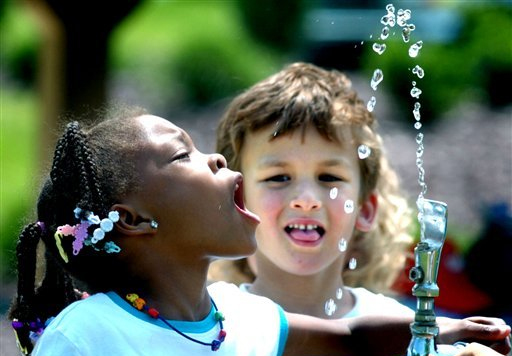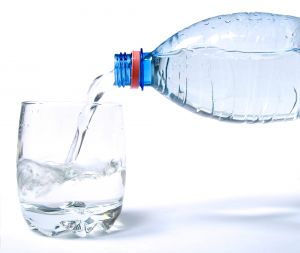I’ve already made kind of a big deal about the fact that children handle the heat differently than adults –and for good reason! When exercising in extreme heat, kids are at an increased risk of heat stress compared to adults. One of the best ways to prevent kids from overheating is to make sure they drink enough water. Dehydration can be dangerous, and it even affects performance. The challenge is in getting kids to drink more water.
Why is Hydration So Important Anyway?
For any given percentage loss in body mass due to sweating, children experience a 50% larger rise in core body temperature than adults. Children, therefore, have a greater need to conserve fluids to prevent a rapid rise in core temperature. This rise in core temperature can strain the cardiovascular system and lead to central nervous system fatigue, resulting in lower sweat rates and less blood flow to the skin –which is their main mechanism for thermoregulation in hot temperatures.
Not only does dehydration make it harder to keep cool, but it can also affect performance. Studies have shown that a 1% decrease in body mass from sweat loss in children leads to decreased endurance, and dehydration of just 2% impaired basketball skills in boys 12 to 15 years of age. Dehydration may lead to protein and glycogen breakdown as well, while proper hydration has been shown to help facilitate protein synthesis.
 Water or Sports Drinks?
Water or Sports Drinks?
Children should be drinking water most of the time. If they exercise or play intensely for 70 to 90 minutes or more, then a sports drink might be warranted. The concentration of children’s sweat is different than that of adults. During exercise in the heat, children lose more potassium than adults, but less sodium and chloride. Overall, children’s sweat has a lower electrolyte concentration. This important adaptation helps them conserve electrolytes while exercising in the heat. In addition to conserving more electrolytes, kids primarily use fat as a fuel source, so they don’t have as much of a need to replace sugar and electrolytes. It makes sense, then, to make sure kids are getting enough healthful fats in their diet, such as full fat yogurt and string cheese, avocados, nuts, or olive oil with their vegetables. If children do need an extra boost, coconut water is a better option than a sports drink. It is higher in potassium than commercial sports drinks and has no added sugar beyond the naturally occurring sugars.
You Can Lead a Kid to Water…
Kids don’t hydrate fully, even with open access to water. Strategies to improve this include:
Increase palatability by changing the temperature, color, and flavor.
Better results (45%) were achieved with flavored water in voluntary drinking to avoid dehydration. In one study with boys who were exercising intermittently for 3 hours in the heat, drinking increased by 90% with flavored water. (Falk & Dotan, 2008)
Add some salty foods or drinks.
Salt stimulates thirst. Thirsty kids drink more water.
Did You Know?
Educate.
Teach children about the importance of drinking fluids. Here are some talking points:
o Over 3/4 of our body is made of water.
o Just 7 days without water could lead to death.
o Water is needed to maintain an appropriate body temperature.
o Water is necessary to maintain proper blood volume, so the heart doesn’t have to work too hard to pump blood throughout the body.
o Water helps joints and other body tissues stay lubricated and healthy.
o Water is vital for transporting nutrients and removing waste products from the body.
o With less water in the system the urine is more concentrated –so the darker the urine, the greater the dehydration. Have kids check the color of their pee!
How & When?
 o Hydration should begin the day before a sporting event or exercise bout, as well as first thing in the morning before eating or starting any exercise.
o Hydration should begin the day before a sporting event or exercise bout, as well as first thing in the morning before eating or starting any exercise.
o Hydrate every 10 – 20 minutes with 6 – 16 ounces of water before, during, and after prolonged exercise to maintain sufficient gastric volume and promote rapid gastric emptying.
How much?
These are the daily hydration requirements from all sources including food, beverages, and drinking water (Institutes of Medicine Dietary Reference Intakes):
o Boys & girls 4 – 8 years old: 1.7 liters per day
o Boys 9 – 13 years old: 2.4 liters per day
o Girls 9 – 13 years old: 2.1 liters per day
o Boys 14 – 18 years old: 3.3 liters per day
o Girls 14 – 18 years old: 2.3 liters per day
Now, don’t hide your kids in an air-conditioned movie theater all day instead of getting them out and playing! Just keep them hydrated to avoid overheating. Get the kids on board by teaching them the importance of water, and they’ll be good to go all summer long.
What do you do to beat the heat and get kids to stay hydrated in the summer?
References
Falk & Dotan. (2008). Temperature Regulation. In N. Armstrong & W. van
Mechelen (Eds.), Paediatric Exercise Science and Medicine (2nd ed., pp. 309-320). Oxford University Press.
Meyer, F., O’Connor, H., & Shirreffs, S. M. (2007). Nutrition for the young athlete.
Journal of Sports Sciences, 25(S1), S73-S82. doi: 10.1080/02640410701607338
Petrie, H. J., Stover, E. A., & Horswill, C. A. (2004). Nutritional concerns for the child and
adolescent competitor. Nutrition, 20(7/8), 620-631. doi: 10.1016/j.nut.2004.04.002
Powers, S. K., & Howley, E. T. (2007). Exercise physiology: Theory and application to
fitness and performance. (6th ed., p. 471). New York, NY: McGraw-Hill.
Craig Valency, MA, CSCS, president and co-founder of SPIDERfit, has been a personal trainer for the last 11 years. He is currently working at Fitness Quest 10 in San Diego, an elite personal training and athletic conditioning facility. He specializes in youth strength and conditioning programs that promote physical literacy, injury prevention and optimal performance. Along with training youths from 6 to 18 years of age for general fitness, Craig has also worked with some of the top junior tennis players in the world. He has been a physical education consultant for the Stevens Point school district in Wisconsin for the last 3 years, helping revamp the district wide programming for the K-12 PE curriculum. Craig earned his bachelor degree from UCLA, and Masters Degree in Kinesiology from San Diego State University.






Connect with SPIDERfit!